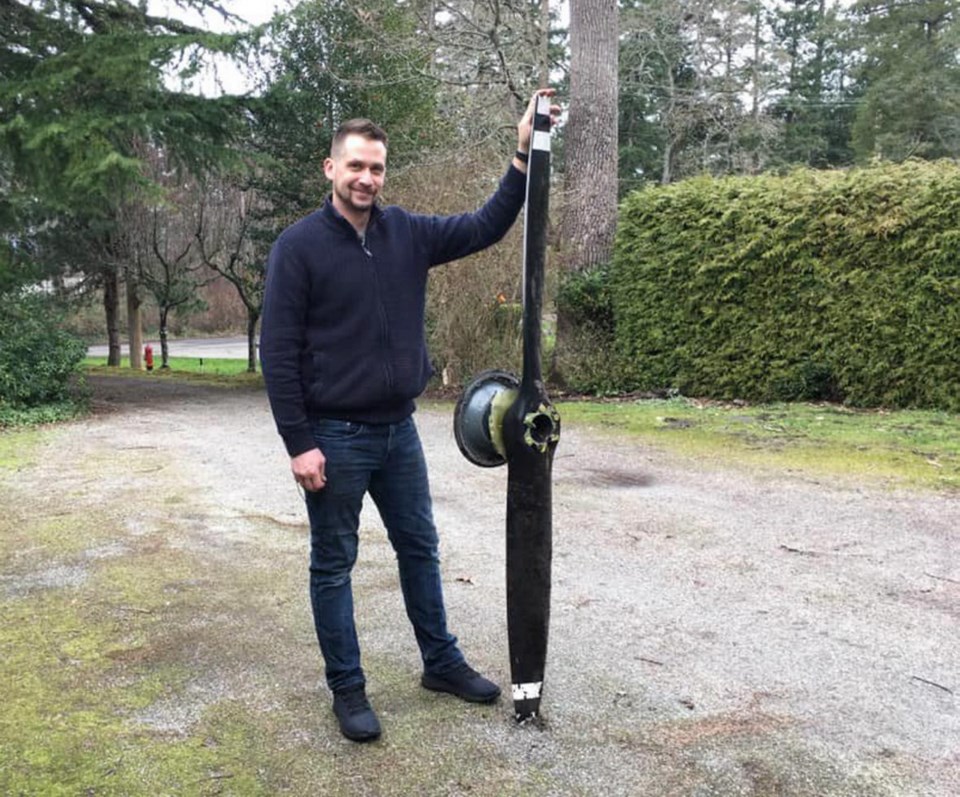An apparent hairline fracture in the crankshaft likely led to a Cessna 172 single-engine plane’s propeller falling off mid-flight over the Blenkinsop Valley, according to a preliminary investigation.
“It’s definitely a problem with that part, there’s no two ways about it,” said Colin Williamson, board president of the Victoria Flying Club. “The question is: Why did it fracture?”
Potential causes to be examined as part of an investigation overseen by Transport Canada include corrosion, a defect in the design or metal, or a problem that came up during maintenance or work on the engine or its rebuild.
Pilot Ryan McCall, 26, was 15 minutes into a flight from the Victoria Flying Club on the morning of Feb. 18 when the propeller fell off, the engine stopped and oil spewed out, covering the windshield.
McCall, with his father beside him as a passenger, was forced to make a crash landing in a blueberry patch in Saanich. The plane flipped once and landed upside down after the landing gear got caught on irrigation lines. Father and son walked away without serious injuries.
“It was purely mechanical — we’re 100 per cent confident it was not his flying skills that caused the problem,” said Williamson, who called McCall’s safe landing “heroic.”
Williamson said once the cause of the cracking is determined, the flying club will determine what, if any, corrective action needs to be taken.
Where the 56-inch propeller ended up was a mystery until Sunday, when Jeremy Francis came upon it embedded in his grandmother’s field.
“I was thinking: ‘Where’s the rest of the plane?’ because this is the most important part,” said Francis. His grandmother remembered there had been a recent plane crash in the area and got on her computer, “and that’s when I learned that there were two occupants and everyone was OK.”
Francis phoned the police and the Victoria Flying Club. “They were so excited to actually find it, to find out the exact cause of what brought the plane down.”
With the go-ahead to remove the more than six-foot sharp blade, he started tugging. “I realized it was the complete propeller with the flywheel still attached to it,” said Francis. “You can tell where it just ripped right off of the propeller shaft and just came flying down and embedded itself over three-quarters of the way into the ground.”
Francis said he was happy to discover that the propeller was not part of an as-yet undiscovered crash or an active criminal investigation.
“I was quite fearful that it was something new — that nobody had known that a plane had come down — so I wanted to definitely find out what was happening and if everyone was OK,” said Francis. “I didn’t know if people died, so I didn’t want to disturb the scene too much.”
When a Victoria Flying Club member came to retrieve the propeller, Francis said the problem with the crankshaft was visible. The crankshaft is the central component within the engine, with the propeller bolted directly to it. It also contains a serial number.
The flying club, which grounded and inspected all its Cessna 172 planes on the day of the crash, re-inspected them on Monday, looking for any similar defects, but nothing was found, said Williamson.
The Victoria Flying Club has nine Cessna 172 “S” newer model planes, and the one that crashed was an older 172 “P,” for a total of 10 Cessna planes.
“Just to be on the safe side, we decided we better go inspect every last plane in our fleet,” said Williamson.
The crankshaft history will have to be traced back to when it was manufactured in 1981, with the help of maintenance records “as far back as we can possibly go.” The plane was acquired by the Victoria Flying Club in 2009, and last overhauled in 2015.
Key will be to determine if the hairline fracture in the crankshaft is an isolated case or more widespread, said Williamson. “We’ll be looking for: Was this truly a one-off thing or is there something … either in our maintenance procedures or the people who rebuild the engines, in their maintenance procedures.”
The goal of the investigation is to determine the cause to prevent further crashes, but not to lay blame.
If the flying club or those who rebuilt the engine did anything wrong, corrective action will be taken, said Williamson.
If a significant defect is found in the design of the part, a notice would go out to everyone who owns that type of aircraft and engine, he said.
The catastrophic failure of the plane’s engine is “definitely troubling,” said Williamson. “That could of been me or my family, my friends or anybody else in that plane and it may not have had the happy ending it did have.”



